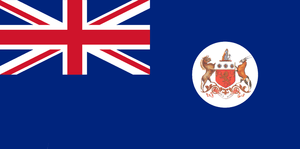William Butler (British Army officer)
| Sir William Butler | |
|---|---|
.png) Lt. Gen. Sir William Butler | |
| Born |
31 October 1838 Golden, County Tipperary, Ireland |
| Died |
7 June 1910 (aged 71) Bansha, County Tipperary |
| Buried at | Killaldriffe |
| Allegiance |
|
| Service/branch |
|
| Rank | Lieutenant General |
| Unit | 69th Foot |
| Commands held | South Africa |
| Awards | Knight Grand Cross of the Order of the Bath |
Lieutenant General Sir William Francis Butler GCB, PC (31 October 1838 – 7 June 1910) was an Irish 19th-century British Army officer, writer, and adventurer.
Military career

He was born at Ballyslatteen, Golden, County Tipperary, Ireland, the son of Richard and Ellen Butler.[1] The great famine of 1847 and scenes of suffering and eviction were amongst his earliest recollections. He was educated chiefly by the Jesuits at Tullabeg College.
He entered the army as an ensign of the 69th Foot at Fermoy Barracks in 1858, becoming captain in 1872 and major in 1874. He took part with distinction in the Red River expedition (1870–71) and the Ashanti operations of 1873–74 under Wolseley and received the Companion of the Order of the Bath in 1874.
He married on 11 June 1877 Elizabeth Thompson, an accomplished painter of battle scenes, notably The Roll Call (1874), Quatre Bras (1875), Rorke's Drift (1881), The Camel Corps (1891), and The Dawn of Waterloo (1895). They had six children.
He again served with General Wolseley in the Zulu War (as brevet lieutenant colonel), the campaign of Tel-el-Kebir (after which he was made an aide-de-camp to the Queen) and the Sudan in 1884–86, being employed as colonel on the staff 1885 and brigadier-general 1885–86. In the latter year he was made a Knight Commander of the Order of the Bath. He served as brigadier-general on the staff in Egypt until 1892 when he was promoted to major-general and stationed at Aldershot, subsequent to which he was given command of the South-Eastern District in March 1896.[2]
In 1898 he succeeded General William Howley Goodenough as commander-in-chief in South Africa, with the local rank of lieutenant-general. For a short period (December 1898 – February 1899), during the absence of Sir Alfred Milner in England, he acted as high commissioner, and as such, and subsequently in his military capacity, he expressed views on the subject of the probabilities of war which were not approved by the home government; he was consequently ordered home to command the Western District, and held this post until 1905.[2] He also held the Aldershot Command for a brief period from 1900 to 1901.[2] Sir William Butler was promoted to lieutenant-general in 1900 and continued to serve, finally leaving the King's service in 1905.
In October 1905, having reached the age limit of sixty-seven, he was placed on the retired list. The few years of life which remained to him he spent at Bansha Castle in Ireland, devoted chiefly to the cause of education. He was a frequent lecturer both in Dublin and the provinces on historical, social, and economic questions. Butler was known as a Home Ruler and an admirer of Charles Stewart Parnell.[3] He was a member of the senate of the National University of Ireland, and a commissioner of the Board of National Education.[1] In June 1906, he was appointed Knight of the Grand Cross of the Order of the Bath, and in 1909 he was made a member of the Irish Privy Council. He died at Bansha Castle and was buried at the cemetery of Killaldriffe, a few miles distant and not far from his ancestral home.
He had long been known as a descriptive writer, since his publication of The Great Lone Land (1872) and other works and he was the biographer (1899) of Sir George Colley.
He had started work on his autobiography a few years before his death, but died before it was completed. His youngest daughter, Eileen, Viscountess Gormanston, completed the work and had it published in 1911. Eileen found among his papers a poem he had written, which began:
Give me but six-foot-three (one inch to spare)
Of Irish earth, and dig it anywhere;
And for my poor soul say an Irish prayer
Above the spot.[1]
Notes
References
| Wikisource has the text of the 1911 Encyclopædia Britannica article Butler, Sir William Francis. |
- William Francis Butler (1872). The Great Lone Land; a Narrative of Travel and Adventure in the North-West of America. London.
- William Francis Butler (1873). The Wild North Land: Being the Story of a Winter Journey, with Dogs, Across Northern North America. London.
- Lieut.-General The Rt. Hon. Sir W. F. Butler G.C.B. (1911). Sir William Butler. An Autobiography London.
- Eileen Gormanston; Atkins (1953). A Little Kept. London & New York.
- Edward Alexander McCourt (1967). Remember Butler. The Story of Sir William Butler. Toronto.
- Martin Ryan (2003) William Francis Butler, a life 1838–1910. Dublin.
External links
| Wikimedia Commons has media related to William Francis Butler. |
- Biography at the Dictionary of Canadian Biography Online
- Works by William Butler at Project Gutenberg
- Works by or about William Butler at Internet Archive
| Military offices | ||
|---|---|---|
| Preceded by Lord William Seymour |
GOC South-Eastern District 1896–1898 |
Succeeded by Leslie Rundle |
| Preceded by Sir Frederick Forestier-Walker |
GOC Western District 1899–1905 |
Succeeded by Command disbanded |
| Preceded by Alexander George Montgomery Moore |
GOC-in-C Aldershot Command (acting) 1900–1901 |
Succeeded by Sir Redvers Buller |
